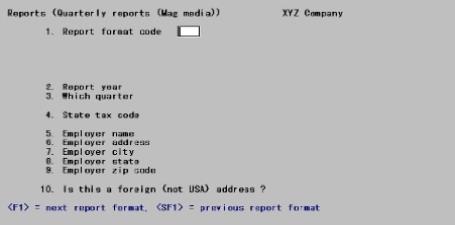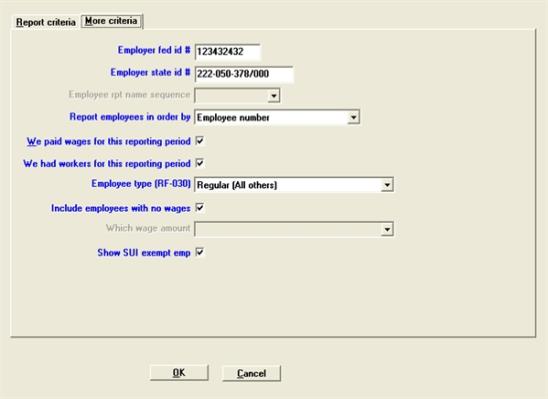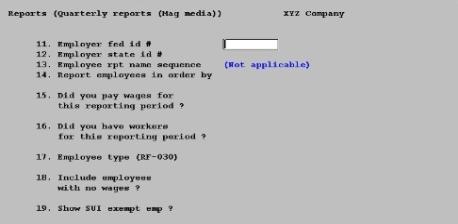
This chapter contains the following topic:
Producing Quarterly Reports on Magnetic Media
Use this selection to produce quarterly reports to state agencies electronically.
These reports can be written directly to your hard disk or other media.
No provision exists for reporting city taxes electronically.
|
Note |
While states rarely change rates during a quarter, if such a change is entered the actual State totals SUI may differ from the sum of the figures in calculated taxes. Enter a SUI change only after reports for the quarter are processed. |
The report format selected must be verified prior to using it.
Select
Quarterly reports (Mag media) from the Reports, general menu.
The following screen displays:
Graphical Mode

Character Mode

Enter the information as follows:
Options
Enter the format code for the report you want to make. The report must previously have been entered and verified in Magnetic media formats, and moreover must have been defined as a quarterly report (rather than an annual one). You can use one of the options:
|
<F1> |
For the next quarterly report format |
|
<SF1> |
For the previous quarterly report format |
|
Format |
Two characters followed by 15 characters. The first two characters typically represent a state abbreviation. |
|
Example |
(No example is given as magnetic media format will not be entered until a later chapter in this documentation) |
Enter the report year for the quarterly electronic report.
|
Format |
9999 The default is the current payroll year from Control information |
|
Example |
(No example is given) |
Enter the quarter number for the report: 1, 2, 3, or 4. The ending date is automatically displayed.
|
Format |
One number from 1 to 4 |
|
Example |
(No example is given) |
Enter the state whose information is to be reported. Any value can be entered, but no report will be produced unless this entry corresponds to the first two characters of the tax code for at least one state entry in Tax tables.
|
Format |
Two characters |
|
Example |
(No example is given) |
Options
Enter the employer name to use in the report, or use the option:
|
<F2> |
For the employer name from PR Control information |
|
Format |
44 characters |
|
Example |
(No example is given) |
Options
Enter the employer address to use in the report, or use the option:
|
<F2> |
For the first employer address line from Control information |
|
Format |
35 characters |
|
Example |
(No example is given) |
Enter the employer’s city to use in the report. This field is required.
|
Format |
20 characters |
|
Example |
(No example is given) |
Enter the state postal abbreviation to use in the report. Unless this is left blank, it must be the standard Post Office abbreviation for a state or territory within the United States.
If a non-USA address is being entered, press <Enter> to skip this field. You will be asked to confirm that you wish this field left blank. Press <Enter> to confirm or <F2> to enter a valid state / territory abbreviation.
|
Format |
Two letters |
|
Example |
(No example is given) |
Enter the employer’s ZIP code to use in the report.
If a non-USA address is being entered, press <Enter> to skip this field, or enter a non-standard (foreign) postal code. You will be asked to confirm that this is what you wish to do. Press <Enter> to confirm or <F2> to enter a standard American zip code.
|
Format |
Ten characters. Standard format is either 99999 or 99999-9999. |
|
Example |
(No example is given) |
This is a foreign (not USA) address
Check the box or enter Y if the employer address entered is a foreign (non-USA) address. Leave it unchecked or enter N if the employer address entered is in the USA.
|
Format |
Graphical: Check box where checked is Yes and unchecked is No. Character: One letter, either Y or N. The default is N (even when a foreign zip or state has been entered) |
|
Example |
(No example is given) |
Use Tab or Enter key to bring up the next screen to enter more criteria:
Graphical Mode

Character Mode

Enter the information as follows.
Options
Enter the employer’s federal tax identification number, or use the option:
|
<F2> |
For the tax ID number from the federal tax record(available only if the tax ID number in the federal tax record is entered as nine digits in one of the formats 99-9999999, 999-99-9999, or 999999999) |
|
Format |
999999999 |
|
Example |
(No example is given) |
Options
Enter the employer’s state withholding tax identification number, or use the option:
|
<F2> |
For the tax ID number from the state tax record (available only if Field #4 corresponds to at least one entry in Tax tables) |
|
Format |
15 characters |
|
Example |
Employee number |
This field is skipped unless the format you are using (as defined in Magnetic media formats) includes the field RF-031 Employee report name sequence.
Enter F to specify that employee names are reported with first name first, or enter L to specify that employee names are reported with last name first.
When you include employee names in an electronic report file, you can choose from a variety of formats. Some states require notification of how you are reporting employee names (either first name first or last name first). You use this parameter in conjunction with field RF-031 Employee report name sequence to provide this notification to your state.
|
Format |
One letter, either F or L |
|
Example |
(No example is given) |
Enter which employee field you want the report to be sorted by. Each field has a number, and these are listed in the State Magnetic Media Report Fields appendix.
Graphical Mode:
|
Format |
Drop down list of choices. Default is Employee number. |
|
Example |
Employee number |
Character Mode:
The format of a field number consists of a prefix EF or EX, followed by am arbitrary number. The prefix indicates whether this is a regular or extended field, respectively. All of these fields are in the Employees selection. Recall that extended fields are user-defined.
Employees are sorted on this field within the “Group ordered by field” specified in the report format’s General appearance screen.
Upon entry of a valid field number, its name displays alongside.
Options
To avoid looking up the appendix, you can use one of the following options. These let you select the three most popular fields directly, or to display a window from which you can select any field.
|
<F1> |
To display a list of employee fields |
|
<F3> |
To display a list of employee extended fields |
|
<F5> |
To order employees by social security number |
|
<F6> |
To order employees by name |
|
<Enter> |
To order employees by employee number |
If you choose to display a window of either the regular or the extended fields, all of the fields are displayed in a scrollable table, one column wide. The current field is highlighted. Use <Up>, <Down>, <PgUp>, <PgDn>, <Home>, and <End> to move to the desired field. Alternately, you can enter a field number directly. The table will scroll to that point. Either way, when you have selected the desired field press <Enter> to select it.
|
Format |
Two characters (EF or EX) followed by 999 |
|
Example |
(No example is given) |
We paid wages for this reporting period
Check the box or enter Y if you paid wages for the reporting period. Uncheck the box or enter N if you did not pay wages for the reporting period.
|
Format |
Graphical: Check box where checked is Yes and unchecked is No Character: either Y or N. The default is Y. |
|
Example |
(No example is given) |
We had workers for this reporting period
Check the box or enter Y if you had workers for the reporting period. Uncheck the box or enter N if you did not have workers for the reporting period.
|
Format |
Graphical: Check box where checked is Yes and unchecked is No. Character: either Y or N. The default is Y. |
|
Example |
(No example is given) |
Options
The Social Security Administration requires that you identify the type of employee you are reporting. Enter the employee type for the employees you are including in the report. Your choices are:
| Character | Graphical |
|
A |
Agricultural |
|
H |
Household |
|
M |
Military |
|
Q |
Medicare-qualified government employee |
|
X |
Railroad |
|
R |
Regular (i.e., all others). |
|
Format |
Graphical: Drop down list of selections (see above) Default is Regular (All others) Character: One letter from the above list. |
|
Example |
(No example is given) |
Include employees with no wages
Check the box or enter Y to include employees with no wages, or uncheck the box or enter N to exclude them.
|
Format |
Graphical: Check box where checked is Yes and unchecked is No Character: One letter, either Y or N. The default is Y. |
|
Example |
(No example is given) |
This field displays only if you answered N to the preceding. Enter what type of wage it is whose absence prevents an employee from being included. Your choices are:
|
A |
Gross wages |
|
H |
SWT gross |
|
B |
Soc. sec. wages (employee) |
|
I |
OST-1 gross (employee) |
|
C |
Medicare wages (employee) |
|
J |
OST-2 gross (employee) |
|
D |
FWT gross |
|
K |
OST gross (employer) |
|
L |
SUI gross (up to the maximum wage) |
|
F |
FUI gross (up to the maximum wage) |
|
M |
SUI total wages |
|
G |
FUI total wages |
|
Format |
One letter from the list above |
|
Example |
(No example is given) |
Check the box or enter Y if you want to print items for employees exempt from state unemployment insurance payments.
A checked box (Y) answer means that such employees are included in addition to (not instead of) the employees who are not exempt.
|
Format |
Graphical: Check box where checked is Yes and unchecked is No Character: One letter, either Y or N. The default is N. |
|
Example |
(No example is given) |
Select OK to generate the file or Cancel to return to the menu without reporting.
Graphical Mode
Make any changes needed. Press <Enter> to continue.
On Windows-based systems, you are next asked for the disk drive on which to output the electronic report file. Enter the drive letter and press <Enter>.
On Thin client and Linux systems the report is written to the server (host) hard drive and you are not prompted for a drive letter.
A report file is created with the file name entered when the report format was defined. Refer to your state reporting guidelines for the media format required by your state.
Regardless of operating system, it is a good idea to have three copies of this file: one to send to the IRS, another as an archive, and a third for a working copy for reference in case the IRS has any questions.